The Toshiba TR200 3D NAND SSD Review: One Step Forward, One Step Back
by Billy Tallis on October 11, 2017 7:00 AM ESTRandom Read Performance
Our first test of random read performance uses very short bursts of operations issued one at a time with no queuing. The drives are given enough idle time between bursts to yield an overall duty cycle of 20%, so thermal throttling is impossible. Each burst consists of a total of 32MB of 4kB random reads, from a 16GB span of the disk. The total data read is 1GB.

The QD1 burst random read speeds of the Toshiba TR200 are mostly normal for a budget SSD, though the 960GB model is notably slower than the smaller capacities that are using the 256Gb NAND dies instead of the 512Gb dies.
Our sustained random read performance is similar to the random read test from our 2015 test suite: queue depths from 1 to 32 are tested, and the average performance and power efficiency across QD1, QD2 and QD4 are reported as the primary scores. Each queue depth is tested for one minute or 32GB of data transferred, whichever is shorter. After each queue depth is tested, the drive is given up to one minute to cool off so that the higher queue depths are unlikely to be affected by accumulated heat build-up. The individual read operations are again 4kB, and cover a 64GB span of the drive.

On the longer test that includes higher queue depths, the Toshiba TR200 falls to near the bottom of the chart. The 240GB and 960GB models are substantially slower than anything else we've tested of similar capacity. On the other hand, the 480GB TR200 is tied with the 525GB Crucial MX300, and the trend suggests that the 275GB Crucial MX300 would score a bit worse.
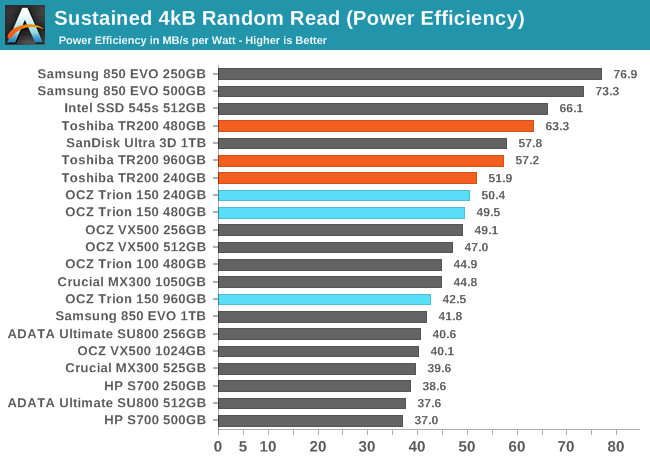
The power efficiency of the Toshiba TR200 during random reads is good, and a clear improvement over the TR150. Notably, the 960GB TR200 scores about the same as the SanDisk Ultra 3D 1TB, showing that the latter's higher performance is in proportion to the power cost of its DRAM.
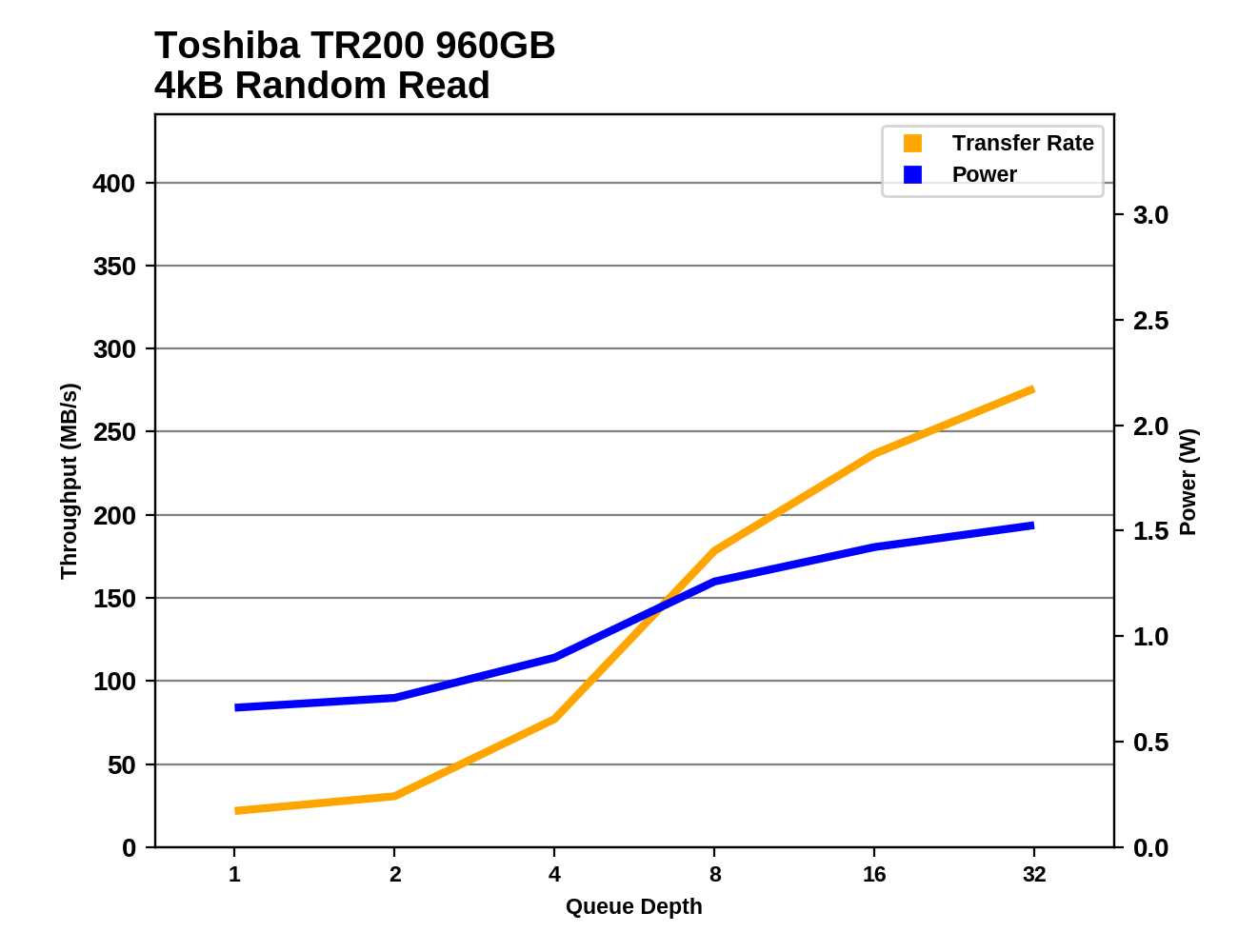 |
|||||||||
The TR200s all show very little random read performance increase from QD1 to QD2, and this is most of why their performance scores above are so low. Through the mid range of queue depths, the TR200 shows better scaling than many other budget SSDs, but at the high end the performance increases taper off. The 960GB model never provides substantially higher performance than the 480GB model, as both have the same number of NAND dies.
Random Write Performance
Our test of random write burst performance is structured similarly to the random read burst test, but each burst is only 4MB and the total test length is 128MB. The 4kB random write operations are distributed over a 16GB span of the drive, and the operations are issued one at a time with no queuing.
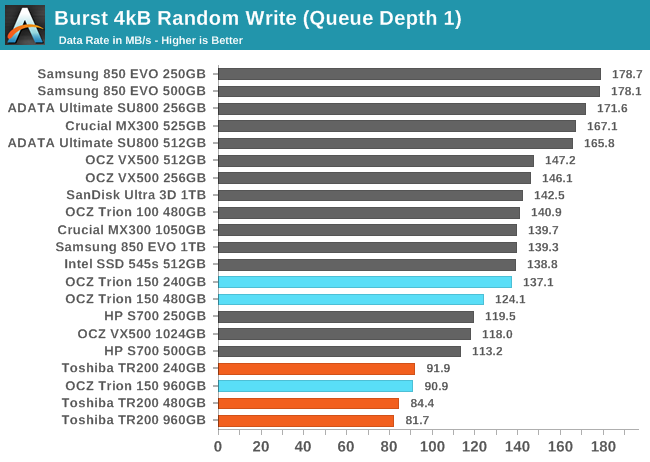
The Toshiba TR200s are the slowest drives for short bursts of random writes at QD1. The larger drives are slower, a pattern that the TR150 and several other models exhibit.
As with the sustained random read test, our sustained 4kB random write test runs for up to one minute or 32GB per queue depth, covering a 64GB span of the drive and giving the drive up to 1 minute of idle time between queue depths to allow for write caches to be flushed and for the drive to cool down.
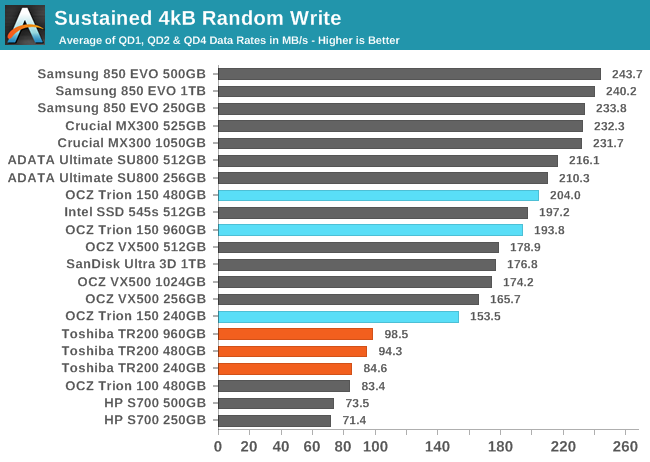
On the longer test of random writes involving some higher queue depths, the gap between the TR200 and a typical mainstream SATA SSD widens to a factor of two or more, but the TR200 also ends up ahead of the HP S700 and the original Trion 100.
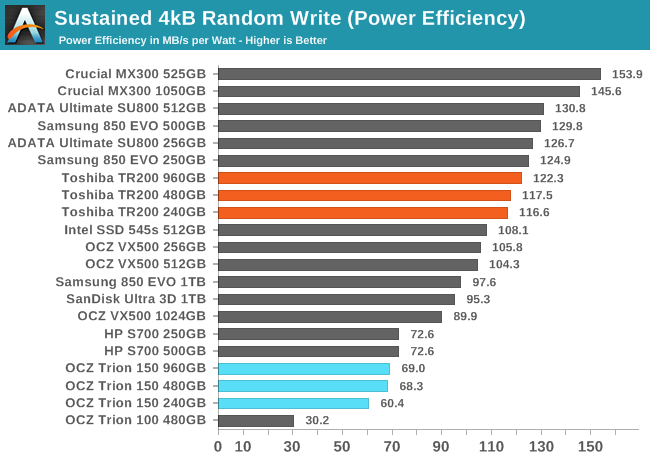
In spite of the poor sustained random write performance, the Toshiba TR200 shows above average power efficiency. This is a huge change relative to previous Trion/TR series drives, which were the least efficient drives on this test. The HP S700 also showed very poor efficiency during random writes.
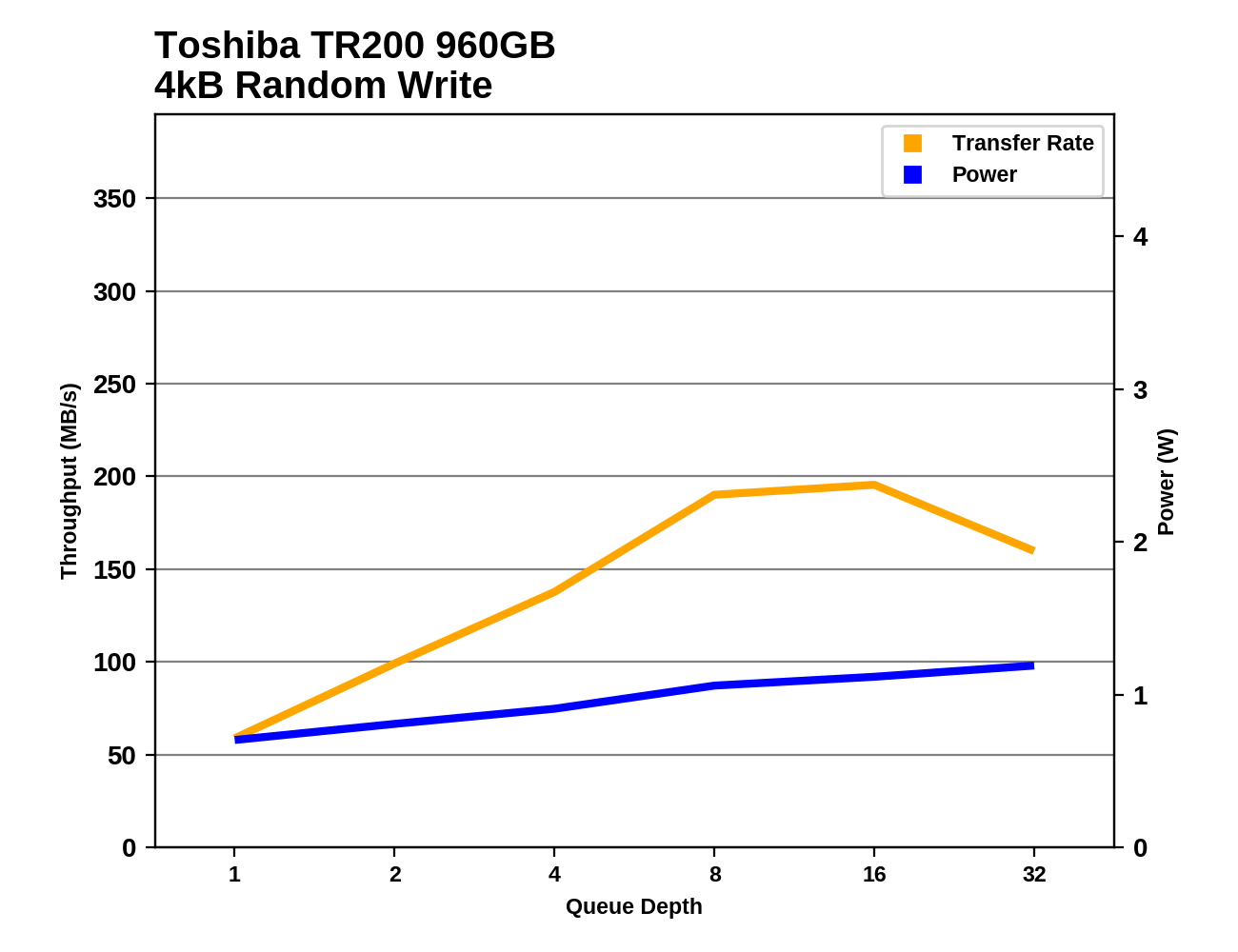 |
|||||||||
The 960GB TR200 shows steady performance scaling as queue depths increase, but by the end of the test its SLC cache has filled up and performance begins to drop. The smaller TR200s also saturate by around QD8 and hold steady at very low performance levels. Power also stays low even at higher QDs, with the 240GB model never exceeding 1W.










50 Comments
View All Comments
r3loaded - Wednesday, October 11, 2017 - link
Pwned by an 850 Evo but only $10 cheaper. Yay what a surprise.ddriver - Wednesday, October 11, 2017 - link
Cudos to toshiba for making an ssd that is as slow in sequential writes as a mechanical hdd. I can't imagine it was easy.It's a serious contender for "lousiest sata ssd of 2017".
masouth - Wednesday, October 11, 2017 - link
of just 2017?takeshi7 - Wednesday, October 11, 2017 - link
correction: slower than an hdd in sequential writes. But then again a lot of these cheap TLC drives have lower sustained write speed than HDDs. What really amazes me is that Toshiba actually made an SSD that's worse than the Crucial BX200. I never thought that would be possible.Samus - Wednesday, October 11, 2017 - link
At 1/10th the power consumption though. As hard as it is to defend this drive, it’s clear toshiba had a very specific goal in mind with this drive: cheap upgrades for cheap laptops. As an OEM supplier for many vendors (including even Apple) this drive is adequate for many sub-$500 laptops: being dramless makes power loss protection mostly unnecessary as it will likely recover from sram loss inside the controller, as the indirection table is mirrored off then back to the nand after each write.However, I’ve never been a fan of dramless controllers. Seams like a mind boggling corner to cut when the cost of 512mb DDR3 is $4.
Lolimaster - Wednesday, October 11, 2017 - link
Fact is Crucial MX300 is as cheap and way better, my way way way better,Samus - Sunday, October 15, 2017 - link
I've long stood by that assertion. Crucial and Samsung SSD's are the only mainstream drives worth considering. Sure, Sandisk, Intel, even Mushkin have their niche products, but Samsung and Crucial have no real "duds."Flunk - Wednesday, October 11, 2017 - link
Has Anandtech reviewed another budget SSD that's competitive with the 850 Evo, seems like that's the gold standard at the moment. I just bought one for my Mom for Christmas.theramenman - Wednesday, October 11, 2017 - link
The SanDisk Ultra 3D they reviewed a bit ago gets similar performance to a 850 Evo for $43 less (at least for the 1TB version).sonny73n - Thursday, October 12, 2017 - link
3 most valued SSD models currently on Amazon. One of them is the BX300 with capacity max out at 480GB which I can only compare it to the similar of the other 2.- Samsung 850 Evo 500GB $160
- SanDisk Ultra 3D 500GB $170
- Crucial BX300 480GB $145
The first 2 are made of TLC NAND and the BX300 is made of MLC. No brainer to pick the best one here.